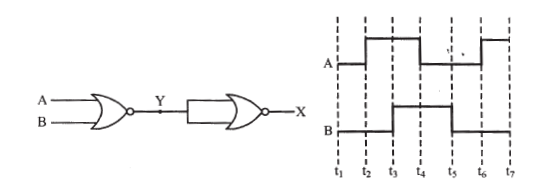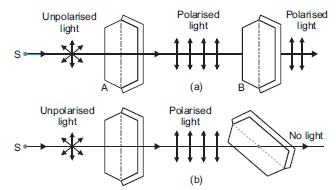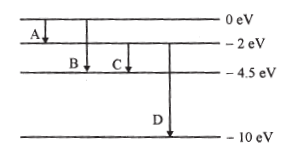 Short Answer Type
Short Answer TypeDraw the output waveform at X, using the given inputs A and B for the logic circuit shown below. Also, identify the logic operation performed by this circuit.

Name the semiconductor device that can be used to regulate an unregulated dc power supply. With the help of I-V characteristics of this device, explain its working principle.
Draw the transfer characteristic curve of a base biased transistor in CE configuration. Explain clearly how the active region of the V0 versus Vi curve in a transistor is used as an amplifier.
(i) Define modulation index.
(ii) Why is the amplitude of modulating signal kept less than the amplitude of carrier wave?An electron and a photon each have a wavelength 1.00 nm. Find
(i) their momenta,
(ii) the energy of the photon and
(iii) the kinetic energy of electron.Draw a schematic diagram showing the (i) ground wave (ii) sky wave and (iii) space wave propagation modes for EM waves.
Write the frequency range for each of the following:
(i) Standard AM broadcast
(ii) Television
(iii) Satellite communicationDescribe Young's double slit experiment to produce interference pattern due to a monochromatic source of light. Deduce the expression for the fringe width.
(a) Describe briefly, with the help of suitable diagram, how the transverse nature of light can be demonstrated by the phenomenon of polarization.
(b) When unpolarized light passes from air to a transparent medium, under what condition does the reflected light get polarized?a) Light from a source S is allowed to fall normally on the flat surface of a thin plate of a tourmaline crystal, cut parallel to its axis. Only a part of this light is transmitted through A. If now the plate A is rotated, the character of transmitted light remains unchanged. Now another similar plate B is placed at some distance from A such that the axis of B is parallel to that of A. If the light transmitted through A is passed through B, the light is almost completely transmitted through B and no change is observed in the light coming out of B.

If now the crystal A is kept fixed and B is gradually rotated in its own plane, the intensity of light emerging out of B decreases and becomes zero when the axis of B is perpendicular to that of A. If B is further rotated, the intensity begins to increase and becomes maximum when the axes of A and B are again parallel. Thus, we see that the intensity of light transmitted through B is maximum when axes of A and B are parallel and minimum when they are at right angles. From this experiment, it is obvious that light waves are transverse and not longitudinal; because, if they were longitudinal, the rotation of crystal B would not produce any change in the intensity of light.
b) When reflected and refracted rays are perpendicular to each other then, the reflected ray is totally plane polarized.
The energy levels of a hypothetical atom are shown below. Which of the shown transitions will result in the emission of a photon of wavelength 275 nm?
Which of these transitions correspond to emission of radiation of (i) maximum and (ii) minimum wavelength?
